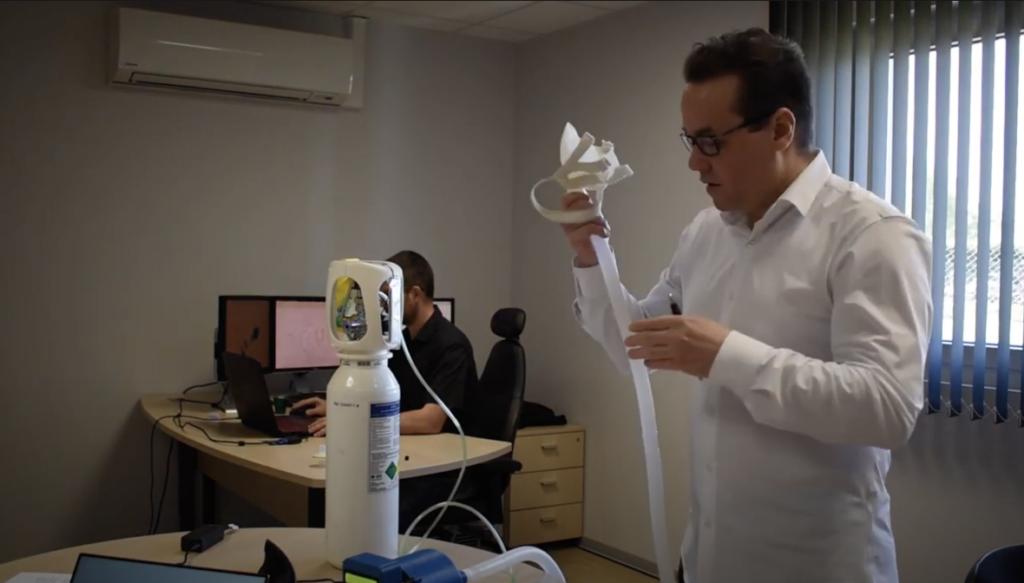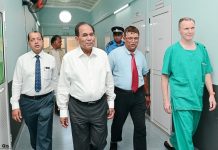Africa-Press – Mauritius. During this period of unprecedented strain on global healthcare systems, governments and hospitals are calling for solutions that will address the shortage of ventilators and other critical equipment to save lives during the pandemic.
In response to this health crisis, a team of scientists, doctors, engineers, students and professionals from Honoris United Universities, the first and largest pan-African network of private higher education institutions, has developed a prototype for a new non-invasive respirator, as well as face shields and splash protection masks, which can be affordably and quickly manufactured via 3D printing.
The Africa Report had a chance to speak to Professor Nidhal Rezg, the project leader, about this prototype and how it may help countries better deal with the COVID-19 pandemic. The Africa Report: How many organisations are working together on this project?
Nidhal Rezg: The 3D non-invasive respirator project is led by [me] and developed by the Polytechnic Engineering School of Université Centrale in Tunisia, a member institution of Honoris United Universities, in partnership with Digital Industry Tools Expert (DITEX).
DITEX brings together the expertise of Dassault Systems, Université de Lorraine in France, and industrial engineering company TECH-3D. In addition, a team of doctors from within the Honoris network – which included the eminent surgeon and director of the Honoris Medical Simulation Center in Tunisia, Chadli Dziri MD and his colleague Dr.
Mamoun Ben Cheikh, an anaesthesiologist – led the production of the curative medical technology and the practical application of the respirator. The 3D-respirators are based on what type of materials? How much for production of one? Yet alone an order of 1000?
Our main objective in producing the respirator was to ensure that it is affordable, easy, quick to produce and most importantly available to everyone.
Therefore, the choice of materials used for the respirator have been specially selected and are easily accessible in most parts of the developing world, making it accessible to most.
The respirator can be 3D-printed in only 12 hours. The production-ready design of the respirator is available in OPEN SOURCE software and can be downloaded free via the site shared by the project partners.
This comes with a free instruction manual with special guidance on the operation of the respirator for ease of use. The device has also been designed to be used in both a hospital and a home setting.
The device is illustrated below. It consists of four intrinsic modules, including the mask, the venture, the electronic card-based ventilator control mechanism, and the insufflator.
The device is then easily connected to an oxygen tank. Polyvalence of the proposed device: An industrial ventilator with non-invasive ventilation usually costs around €4,000 but the cost to produce this new device is estimated to be less than €180.
It is, however, not useful to compare the two devices: we are fighting against a virus and we need fighting tools that are functional and available in different parts of the world particularly in Africa, where our health systems are fragile and can at any time be overwhelmed during the COVID-19 pandemic.
Countries all over the world are struggling with a shortage of ventilators as the crisis unfolds. Our solution will address this challenge as it is available in OPEN SOURCE for rapid use against respiratory pathologies due to Coronavirus and easy to duplicate in most parts of the developing world.
Have the respirators been used in hospitals? If so, where? It should be noted that 20% of patients with COVID-19 have acute respiratory failure and 15% require non-invasive ventilation. Our respirator is a solution for this 15%. Our respirator is cost-effective and has been designed to be used in both a hospital and a home setting.
Our respirator has been tested in the intensive care unit of the Saint-Pierre University Hospital Centre in Brussels, Belgium and the results showed that the device can also be used for patients suffering from chronic obstructive sleep apnoea.
However, the second version of the prototype developed requires approval and industrialisation for mass production. We are currently working with OneTech, a manufacturing company in Tunis, which has expressed an interest in contributing to the production of our respirator.
We have also submitted the device to the Ministry of Health in Tunisia for registration and approval. Will this technology allow countries to be self-sufficient in producing such vital equipment? The growing COVID-19 crisis has highlighted the inadequacy of available equipment in the global healthcare industry.
Many health institutions are raising concerns about the shortage of key equipment that is so desperately needed to treat critically ill COVID-19 patients, including ventilators and personal protective equipment (PPE) for frontline medical staff.
Medical, scientific and engineering innovators have demonstrated that they play an important role in the development of new technological solutions in medicine and in the production of ventilators to alleviate COVID-19 related shortages.
Our solution is easy to duplicate and available in OPEN SOURCE software without patent for quick use against respiratory pathologies due to the coronavirus.
The respirator can be 3D-printed in only 12 hours. The components used are reliable and inexpensive and they are also available on the market in different countries all over the world.
With initiatives like this, it is important to encourage collaboration between institutions (academics and industry) to ramp up the production of respirators amid the COVID-19 pandemic.
Can this cooperation extend beyond Africa? Can the technology be sold to other countries in need of equipment such as in Europe, the Americas or even Asia?
The device can be easily duplicated in different countries in Africa and around the world using a software that can be downloaded free of charge. We are also calling on governments and 3D-printing companies to download and produce the respirators to support the fight against the COVID-19 pandemic.
For More News And Analysis About Mauritius Follow Africa-Press







